The US Line: My feud with Flexport CEO Ryan Petersen
Just to clarify…
FDX: ABOUT USPS PRIVATISATIONFDX: CCO VIEWFDX: LOWER GUIDANCE FDX: DISRUPTING AIR FREIGHTFDX: FOCUS ON KEY VERTICALFDX: LTL OUTLOOKGXO: NEW LOW LINE: NEW LOW FDX: INDUSTRIAL WOESFDX: HEALTH CHECKFDX: TRADING UPDATEWMT: GREEN WOESFDX: FREIGHT BREAK-UPFDX: WAITING FOR THE SPINHON: BREAK-UP ALLUREDSV: BREACHING SUPPORTVW: BOLT-ON DEALAMZN: TOP PICK
FDX: ABOUT USPS PRIVATISATIONFDX: CCO VIEWFDX: LOWER GUIDANCE FDX: DISRUPTING AIR FREIGHTFDX: FOCUS ON KEY VERTICALFDX: LTL OUTLOOKGXO: NEW LOW LINE: NEW LOW FDX: INDUSTRIAL WOESFDX: HEALTH CHECKFDX: TRADING UPDATEWMT: GREEN WOESFDX: FREIGHT BREAK-UPFDX: WAITING FOR THE SPINHON: BREAK-UP ALLUREDSV: BREACHING SUPPORTVW: BOLT-ON DEALAMZN: TOP PICK

As global demand for box ship capacity continues to dramatically outstrip supply, the number of idled vessels is down to numbers not seen since the pandemic.
According to new Alphaliner data, in the first half of the year, commercially idle tonnage represented an average of 0.7% of the container shipping fleet, “harking back to levels seen during the pandemic”, it reported.
It averaged around 210,000 teu, out of the 29.6m teu global cellular fleet, matching numbers recorded in the first half of 2022.
Alphaliner data showed just 77 ships of 217,038 teu currently without revenue-generating activity and, as carriers continue to seek any available tonnage to maintain services, none are over 18,000 teu and only two are above 12,500 teu.
Stanley Smulders, director of marketing and commercial for ONE, previously told The Loadstar: “If you look at all the statistics, there are no ships idle. Every single vessel is actually working. All the shipping lines are in need of ships at the moment.”
During yesterday’s Flexport Freight Market Update, the forwarder warned that spot rate price surges would continue until capacity supply outstripped demand.
And Flexport’s senior manager for ocean freight North Germany, Lasse Daene, added: “Unfortunately, this development on the spot market has an influence on the long-term market.
“Long-term rates are, in the current times, below the current spot rates, so carriers are trying to limit the capacity offer to the long-term agreements and are using peak season surcharges to close the gap. This development will continue until, structurally, supply outperforms demand and load factors out of Asia begin to reduce.
“But at the moment, we are still hearing that almost all vessels are running at 100%, which is the driver for this surge.”
And Alpahaliner noted that as vessels larger than 4,000 teu become increasingly scarce, the number of forward fixtures of bigger ships being delivered later this year and next has risen sharply.
“This appears surprising at first sight, considering the current demand boom is, for a large part, driven by short-term factors such as the Cape of Good Hope diversions and an early peak cargo season,” the analyst wrote.
However, it explained that this reflected carrier expectation that Suez routings were unlikely to reappear any time soon.
It added: “Higher-than-expected cargo volumes, on the back of a global economy performing better than expected, despite the numerous geopolitical challenges, can also explain a certain confidence from carriers.”
Comment on this article